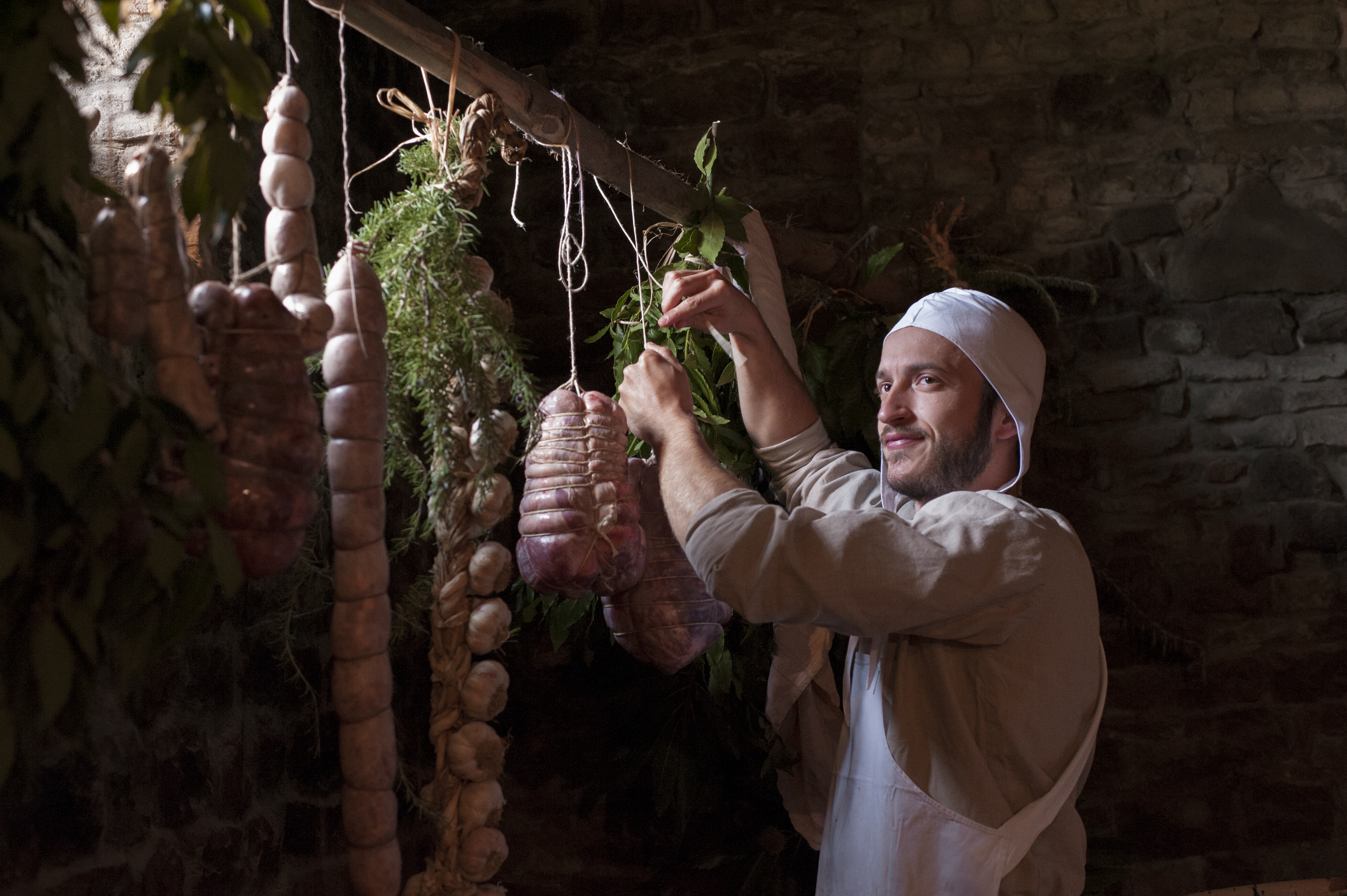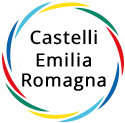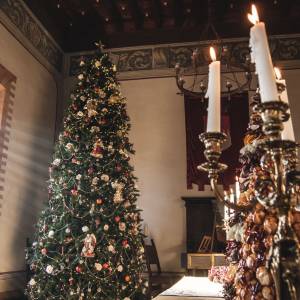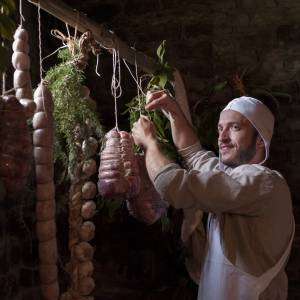Emilia Romagna Castles
Gran Festa a Corte: discovering the historical cuisine of Gropparello Castle
Of Castello di Gropparello

Here, every year historical cooking courses are organised for groups of people and period tables are laid in October during the Gran Festa a Corte event.
The Gropparello Castle in the province of Piacenza is a special place among the Castles of the Duchy where you can rediscover the customs and dishes of historical cuisine. Here, every year historical cooking courses are organised for groups of people and period tables are laid in October during the Gran Festa a Corte event.
For almost twenty years, Grande Festa a Corte has been a passionately cared for family celebration, when the kitchen comes alive again and makes guests dream, with its scents, its sounds, the crying of babies held at nursery by the maidservants, the chattering, the lapping of water in the sink and the rhythmic beating of knives and pestles. A great choreography animated by actors and enthusiasts, people of the trade who recreate at Gropparello Castle this beautiful atmosphere between historical imagination and sensory experience.
It is the perfect opportunity to visit the ancient kitchens of the stronghold. Surprise is guaranteed in listening to the secrets of the castle's real cold store, not too deep but ingeniously kept cold, where anything could be stored, 'including those foods of animal origin so beloved in Renaissance cuisine but so perishable and delicate,' as Chiara Maria Gibelli of the family that owns Gropparello Castle explains, 'Fat and tender offal, used for sweetbread pies; ox marrow and brains, used to make creamier the filling of pies that we would call 'savoury', but in which in reality flavours were mixed without prejudice, upsetting our architecture of taste; butter and lard in large quantities, particular vegetables that could come from distant markets, farmed meats and game meats, fresh cheeses, milk. Medieval and Renaissance recipe books overflowed with these marvels, and used them generously, because on the table of the nobleman the most important battles were often fought, those in which economic power, hierarchical superiority, taste, culture and the very magnificence of the master of the house were displayed'.
In Gropparello Castle, on the ground floor, below the upper floor of the noble rooms, were the servants' quarters and therefore also the kitchen brigade.
"Here we have a room that is very different from the others, completely made of stone and never plastered. With very small windows and a floor hollowed out about one and a half metres from the ground floor, it is the room that since the early Middle Ages - the walls are part of the 1150/1200 building - was the pantry with icebox. Its shape is basically a kind of funnel, now made regular by the wooden floor that was put in place in the 20th century to close off the part dug deeper, i.e. the icebox or neviera.
But if we were to imagine removing that wooden floor, and removing the terracotta with which the room was re-floored, then we would have a very different effect: a room that looks like a cave, dark - the small windows prevented the light and heat of the sun from entering and spoiling the provisions - and cool, dug out of the living rock and equipped with a pit that occupies a quarter of the chamber, further dug out by about two metres. Snow was thrown in here in winter, pressed and crushed to form a heart of ice wedged in the very bowels of the rock, which kept the room cold all year round'.
A real cold room then, not too deep but ingeniously kept cold.
Gropparello Castle has always remained inhabited, even in the last century. As it still is today: "Inevitably, the transformations in technology, society and the very life of families in castles has led to some logical changes also in the use of spaces, in the way of inhabiting them".
Our journey among the historic kitchens of the Castles of Emilia Romagna continues. See you soon for the next visit to the kitchens!
Ph. Credits Photo archives Castelli del Ducato - Gropparello Castle
The Castelli Emilia Romagna blog project is co-financed by the European Funds of the Emilia-Romagna Region - Por Fesr 2014-2020. Editing and research by Francesca Maffini and Antonella Fava. Thanks for the availability of the interview Chiara Maria Gibelli of the family that owns Gropparello Castle.
Why write about historical kitchens in Emilia Romagna? The historic kitchens or the most suggestive dining rooms of castles and ancient residences represent in Emilia Romagna one of the most unexpected and special DIY 'tourist routes' to be discovered because, during guided tours of fortresses and manor houses, going in search of period kitchens really means encountering great stories of food and wine, stories of hearths and cauldrons that represent the culinary identity of the territories, stories of iceboxes and storerooms where food, wine, oil and salt were conserved to withstand the harshest months of the year, or where foodstuffs and supplies were stored to cope with famines or sieges.
Why write about period kitchens in Emilia Romagna? The historical kitchens or the most suggestive dining rooms of castles and ancient dwellings represent in Emilia Romagna one of the most unexpected and peculiar do-it-yourself 'tourist routes' to be discovered because, during guided tours of fortresses and manor houses, going in search of period kitchens really means encountering great stories of food and wine, stories of hearths and cauldrons that represent the culinary identity of the territories, stories of iceboxes and storerooms where food, wine, oil and salt were conserved to withstand the harshest months of the year, or where foodstuffs and supplies were stored to cope with famines or sieges.
Numerous castles in Emilia Romagna, as well as abbeys and villas, are characterised precisely by the presence of rooms used centuries ago as kitchens: they were often located in the basement spaces of strongholds, strategically designed and managed to facilitate food supply, preservation and cooking operations in well-defined rooms such as those dedicated to the kitchen, pantries, cellars, ovens or pastry.
In the kitchens, but not only in them, we can find large fireplaces where the ancient spits on which poultry, lambs, piglets or various types of game, often the spoils of the exclusive hunting parties of the nobility, partridges, larks and birds, pigeons or snipe, were roasted.
In the kitchens we can find traces of solutions to improve or facilitate the work or processing of food by the cooks.
We can still admire old tools such as, ovens, iceboxes, pots, dishes, frying pans, grills, handicrafts with copper materials.
In the dining rooms of some castles in Emilia Romagna, service cupboards are exhibited or are exhibited on special occasions, such as theme exhibitions: tables decorated with centrepieces, trays, tablecloths, plates and spaces to keep food warm.
See you soon with the next article and new surprising manors to get to know.
The Castelli Emilia Romagna blog project is co-financed by the European Funds of the Emilia-Romagna Region - Por Fesr 2014-2020. Editing and research by Gianluca Bagnara, Francesca Maffini, Antonella Fava.


